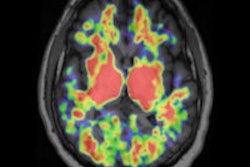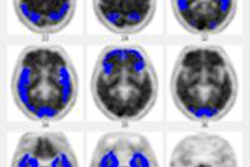PET imaging with carbon-11-labeled Pittsburgh Compound B (PiB) has revealed that high amounts of beta-amyloid plaque in the brain may be a better predictor of future memory loss in mentally healthy older people than the APOE ε4 allele, according to a study in the October 16 issue of Neurology.
Researchers found that after 18 months, healthy individuals who initially had more beta-amyloid plaque had as much as a 20% greater decline in memory skills compared to those with less plaque. And while subjects with the ε4 allele of the apolipoprotein E (APOE) gene showed a greater decline in memory than participants without the allele, the presence of both the APOE ε4 allele and beta amyloid did not further enhance the decline in memory.
In the patients with high beta-amyloid levels, the decline in memory is expected to continue until it reaches levels where the individuals would be classified as having mild cognitive impairment, according to lead study author Yen Ying Lim, from the University of Melbourne in Australia, and colleagues (Neurology, Vol. 79:16, pp. 1645-1652).
Previous research
Previous neuroimaging studies have found abnormally high amounts of beta amyloid in a large amount of healthy older adults, the authors wrote. The association between beta-amyloid levels and cognitive function is small, though, with the strongest relationships found in memory skills.
Other research has suggested a moderate connection between the amount of beta amyloid and memory in individuals with the APOE ε4 allele. APOE ε4 has been shown to accelerate cognitive decline, but it is not known how the allele might affect the relationship between beta amyloid and cognitive decline.
In addition, two previous PiB-PET studies reported no differences between healthy older adults with high and low cerebral beta-amyloid levels in terms of the rate of cognitive change over 24 months, but Lim and colleagues noted that these study cohorts included 30 or fewer participants, and neither study investigated the effect of the APOE genotype.
In this prospective study, 141 healthy and cognitively normal older adults with a mean age of 76 years were recruited from the Australian Imaging, Biomarker, and Lifestyle Flagship Study of Aging (AIBL). The participants had undergone PiB-PET neuroimaging, in addition to completing a series of cognitive tests based on card games and remembering word lists at baseline and again during an 18-month follow-up assessment.
Standardized uptake value (SUV) data were acquired 40 to 70 minutes after PiB injection and normalized to the cerebellar cortex SUV, so researchers could calculate a region/cerebellar ratio (SUVR). In addition, each participant provided a blood sample, 0.5 mL of which was used for APOE genotyping at a clinical pathology laboratory.
The researchers also calculated group mean and standard deviation change scores for each SUVR and APOE group, as well as for SUVR high and low groups averaged over APOE ε4 status, and APOE ε4 carriers and noncarriers averaged over SUVR status.
Beta-amyloid effect
The analysis showed a direct correlation between beta-amyloid plaque as measured by PiB-PET and eventual cognitive decline. Older adults with an SUVR of 1.5 or greater showed "significantly greater decline" at the 18-month follow-up assessment in working memory and verbal and visual episodic memory than older adults with an SUVR of less than 1.5 at baseline. There was, however, no decline at the 18-month follow-up in psychomotor or attention function in either SUVR group.
When APOE ε4 status was factored into the analysis, individuals in the high SUVR group showed a greater decline on tasks involving verbal and visual memory, as well as working memory, at the 18-month assessment.
When considered on its own, the presence of the ε4 allele was associated with a greater decline in visual memory after 18 months, according to the researchers. However, no correlation was seen between APOE ε4 and beta amyloid regarding cognitive function.
"Results of this study support the hypothesis that in healthy older adults high cerebral [beta-amyloid] load is associated with a decline in episodic memory over 18 months," Lim and colleagues concluded. "Compared with the cognitive performance of healthy older adults with normal cerebral [beta-amyloid] load, older adults with high cerebral [beta-amyloid] load showed greater decline across each aspect of episodic memory assessed."
The findings provide an "enormous opportunity for understanding the development of early Alzheimer's disease and even a sound basis for the assessment of plaque-targeting therapies," Lim said in a statement about the study. He did also note, though, that testing for the APOE genotype is easier and much less expensive than beta-amyloid imaging.
The group also recommended the use of more-detailed neuropsychological tests in future studies to better determine the relationship between cerebral beta amyloid and cognitive skills.
|
Study disclosures One study researcher has served on scientific advisory boards for Novartis, Eli Lilly, Janssen, and Pfizer. One other author has received research support from Eli Lilly, GlaxoSmithKline, Forest Laboratories, and Novartis. |



















